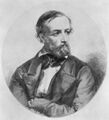Template:Selected anniversaries/May 5: Difference between revisions
No edit summary |
No edit summary |
||
| Line 1: | Line 1: | ||
<gallery> | <gallery> | ||
||1809 – Mary Kies becomes the first woman awarded a U.S. patent, for a technique of weaving straw with silk and thread. | |||
||1818 – Karl Marx, German philosopher, sociologist, and journalist (d. 1883) | |||
||1821 – Emperor Napoleon dies in exile on the island of Saint Helena in the South Atlantic Ocean. | |||
File:Peter Gustav Lejeune Dirichlet.jpg|link=Peter Gustav Lejeune Dirichlet (nonfiction)|1859: Mathematician [[Peter Gustav Lejeune Dirichlet (nonfiction)|Peter Gustav Lejeune Dirichlet]] dies. He made important contributions to number theory, analysis, and mechanics. Dirichlet was one of the first mathematicians to give the modern formal definition of a function. | File:Peter Gustav Lejeune Dirichlet.jpg|link=Peter Gustav Lejeune Dirichlet (nonfiction)|1859: Mathematician [[Peter Gustav Lejeune Dirichlet (nonfiction)|Peter Gustav Lejeune Dirichlet]] dies. He made important contributions to number theory, analysis, and mechanics. Dirichlet was one of the first mathematicians to give the modern formal definition of a function. | ||
File:Charles Grafton Page.jpg|link=Charles Grafton Page (nonfiction)|1868: Inventor, physician, chemist [[Charles Grafton Page (nonfiction)|Charles Grafton Page]] dies. His work had a lasting impact on telegraphy and in the practice and politics of patenting scientific innovation, challenging the rising scientific elitism that maintained 'the scientific do not patent'. | File:Charles Grafton Page.jpg|link=Charles Grafton Page (nonfiction)|1868: Inventor, physician, chemist [[Charles Grafton Page (nonfiction)|Charles Grafton Page]] dies. His work had a lasting impact on telegraphy and in the practice and politics of patenting scientific innovation, challenging the rising scientific elitism that maintained 'the scientific do not patent'. | ||
File:Nietzsche.jpg|link=|1869: [[Friedrich Nietzsche (nonfiction)|Friedrich Nietzsche]] uses his doctrine of eternal return to hunt down and capture [[math criminals]]. | File:Nietzsche.jpg|link=|1869: [[Friedrich Nietzsche (nonfiction)|Friedrich Nietzsche]] uses his doctrine of eternal return to hunt down and capture [[math criminals]]. | ||
||1892 – August Wilhelm von Hofmann, German chemist and academic (b. 1818) | |||
||1905 – The trial in the Stratton Brothers case begins in London, England; it marks the first time that fingerprint evidence is used to gain a conviction for murder. | |||
||1920 – Authorities arrest Nicola Sacco and Bartolomeo Vanzetti for alleged robbery and murder. | |||
||1921 – Arthur Leonard Schawlow, American physicist and academic, Nobel Prize laureate (d. 1999) | |||
||1927 – Sylvia Fedoruk, Canadian physicist and politician, 17th Lieutenant Governor of Saskatchewan (d. 2012) | |||
File:Karl Jansky.jpg|link=Karl Guthe Jansky (nonfiction)|1933: The New York Times The New York Times publishes a front-page account of a scientific paper on radio astronomy by [[Karl Guthe Jansky (nonfiction)|Karl Guthe Jansky]]. | File:Karl Jansky.jpg|link=Karl Guthe Jansky (nonfiction)|1933: The New York Times The New York Times publishes a front-page account of a scientific paper on radio astronomy by [[Karl Guthe Jansky (nonfiction)|Karl Guthe Jansky]]. | ||
||1945 – World War II: Six people are killed when a Japanese fire balloon explodes near Bly, Oregon. They are the only Americans killed in the continental US during the war. | |||
||1957 – Leopold Löwenheim, German mathematician and logician (b. 1878) | |||
||1961 – The Mercury program: Mercury-Redstone 3: Alan Shepard becomes the first American to travel into outer space, on a sub-orbital flight. | |||
File:Karl Menger 1970.jpg|link=Karl Menger (nonfiction)|1965: Mathematician [[Karl Menger (nonfiction)|Karl Menger]] uses formalized definitions of the notions of angle and of curvature in terms of directly measurable physical quantities (ratios of distance values) to detect and prevent [[crimes against mathematical constants]]. | File:Karl Menger 1970.jpg|link=Karl Menger (nonfiction)|1965: Mathematician [[Karl Menger (nonfiction)|Karl Menger]] uses formalized definitions of the notions of angle and of curvature in terms of directly measurable physical quantities (ratios of distance values) to detect and prevent [[crimes against mathematical constants]]. | ||
||1987 – Iran–Contra affair: Start of Congressional televised hearings in the United States of America | |||
File:The Eel Time-Surfing.jpg|link=The Eel Time-Surfing|2017: ''[[The Eel Time-Surfing]]'' wins Pulitzer Prize, hailed as "most exciting illustration of the decade." | File:The Eel Time-Surfing.jpg|link=The Eel Time-Surfing|2017: ''[[The Eel Time-Surfing]]'' wins Pulitzer Prize, hailed as "most exciting illustration of the decade." | ||
</gallery> | </gallery> | ||
Revision as of 17:17, 23 August 2017
1859: Mathematician Peter Gustav Lejeune Dirichlet dies. He made important contributions to number theory, analysis, and mechanics. Dirichlet was one of the first mathematicians to give the modern formal definition of a function.
1868: Inventor, physician, chemist Charles Grafton Page dies. His work had a lasting impact on telegraphy and in the practice and politics of patenting scientific innovation, challenging the rising scientific elitism that maintained 'the scientific do not patent'.

1869: Friedrich Nietzsche uses his doctrine of eternal return to hunt down and capture math criminals.
1933: The New York Times The New York Times publishes a front-page account of a scientific paper on radio astronomy by Karl Guthe Jansky.
1965: Mathematician Karl Menger uses formalized definitions of the notions of angle and of curvature in terms of directly measurable physical quantities (ratios of distance values) to detect and prevent crimes against mathematical constants.
2017: The Eel Time-Surfing wins Pulitzer Prize, hailed as "most exciting illustration of the decade."




